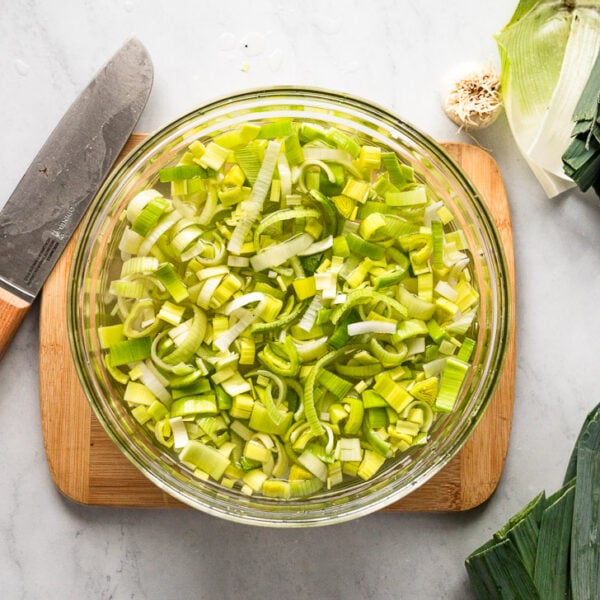Leeks can get a bad rap, seeming like a complicated and intimidating vegetable. Maybe you’ve overlooked them in the grocery store or said “hard pass” to any recipe that calls for the use of leeks. If this is you, never fear, they are much easier to work with than you might think and the flavor they add to recipes is unbeatable!
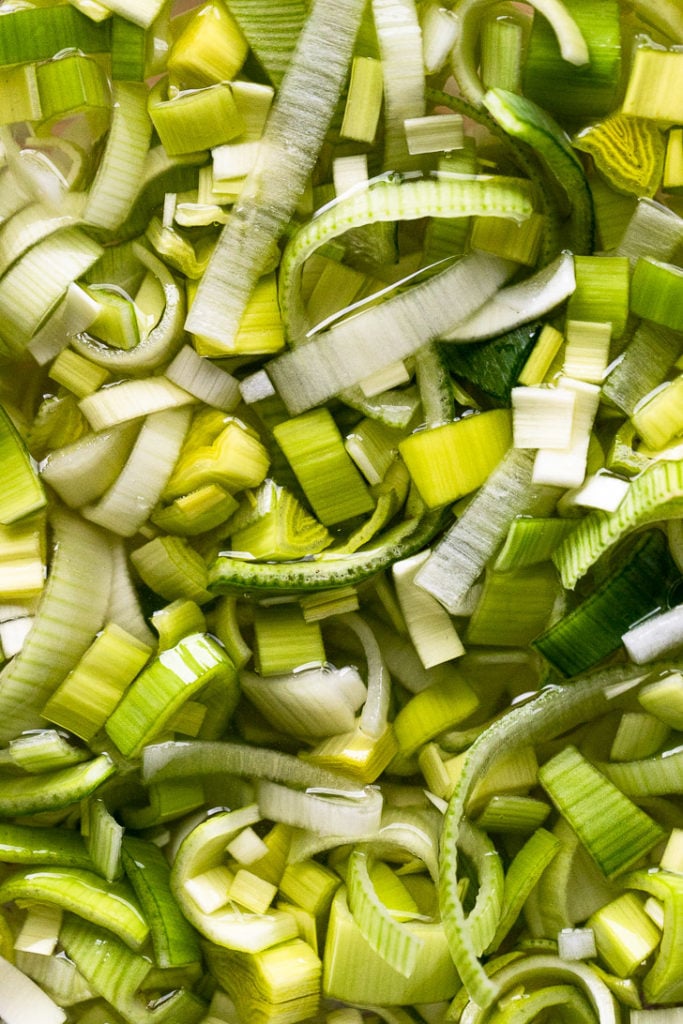
I absolutely love leeks; they add such a depth of flavor with their mild sweetness and less pungent and intense onion flavor than other traditional onions.
I hope this guide helps give you the confidence to get out there and start cooking with them, and yes, in more than just potato leek soup! Some of my favorite leek recipes are below, too!
What are leeks?
A leek is a vegetable that is part of the allium family which is the same family that onion, garlic, shallot, and the sorts are part of. This means it’s also a root vegetable that grows in the loose soil and sand and why it’s so important to clean it well – more on that in a minute!
Leeks have a long cylindrical shape with its root at the end and an array of green colors from white to light green to a dark green top. They are layered inside, similar to an onion.
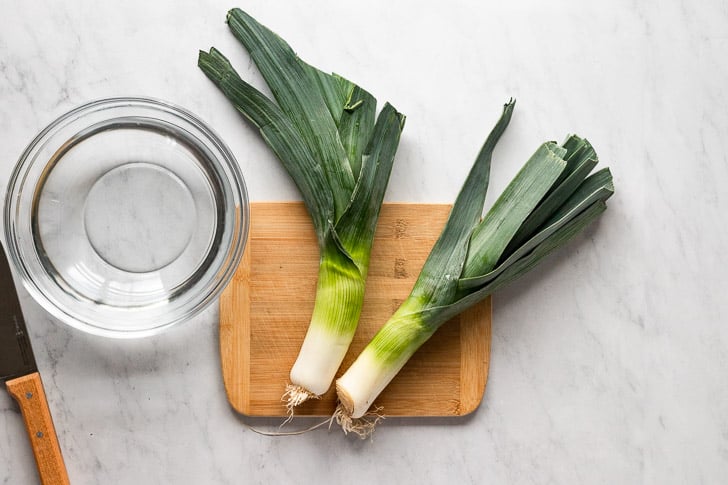
What does a Leek Taste Like?
Leeks are similar to onions in flavor, but they are much milder, more delicate, and a little sweeter. Their flavor adds a lot of depth to recipes like soups and pasta, without being overbearing.
What Part of the Leek Can You Eat?
The most edible parts of leeks are the bottom white and light green parts because they are tender and have the most flavor.
The dark green parts are technically edible but to a lesser extent because they are quite tough. If you do want to eat the dark green parts, be sure to saute them well so they soften. Otherwise, they are commonly saved and used in homemade vegetable stock.
How to Clean Leeks
There are two main ways to clean and prepare leeks. How you go about slicing them will usually depend on how you intend to prepare them or the recipe you’ll be using. As I mentioned, leeks are prone to being very dirty inside because of how they’re grown, so it’s important to clean them well.
Method 1: Slice and Rinse
First, cut the stringy roots off of the leek. If the outer layer seems quite bruised, you can peel it off before continuing, too.
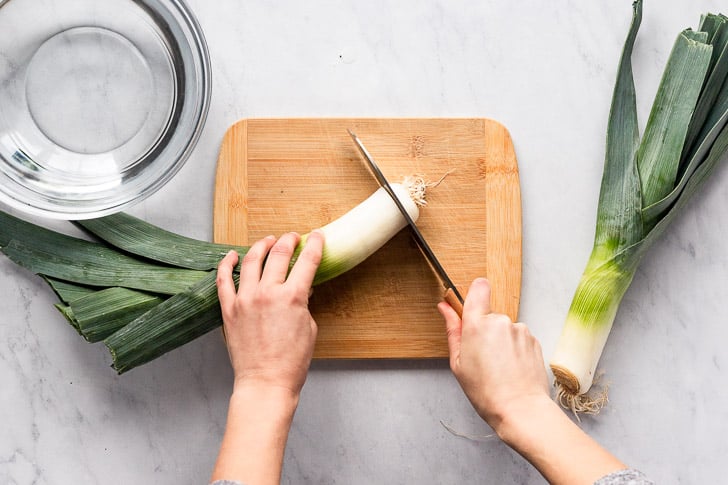
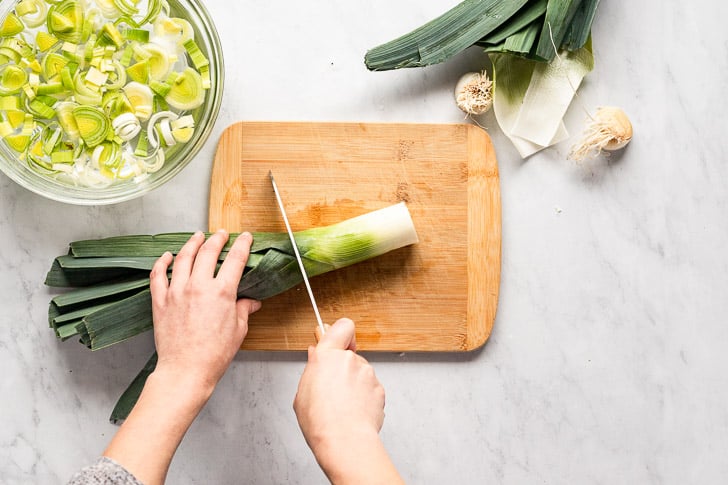
Cut the dark green leaves off of the whole leek, then, slice the leek in half lengthwise. Once you slice it down the middle, you’ll be able to see the layers inside. Run water in the layers to rinse away any dirt and sand inside. Use your fingers to spread apart the layers so the water rinses between each one, too.
Once it’s clean, you can cut it as needed for your recipe.
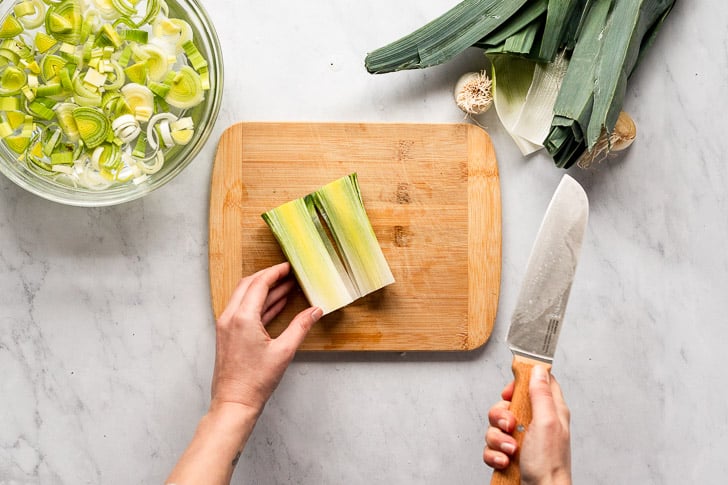
Method 2: Cut, then Dunk
The next method starts the same: cut the stringy roots off of the leek, and if the outer layer seems quite bruised, you can remove it, and slice off the dark green parts if you’re not using them. Always reserve them for homemade stock (you can freeze the tops until ready to make the stock).
Cut the cylinder in half lengthwise, then place the cut side down on your cutting board. Slice the leek in approximately 1/4 to 1/2 inch slices. Place the slices in a bowl of cold water and swoosh them around to loosen any dirt or sand that is stuck in the leeks.
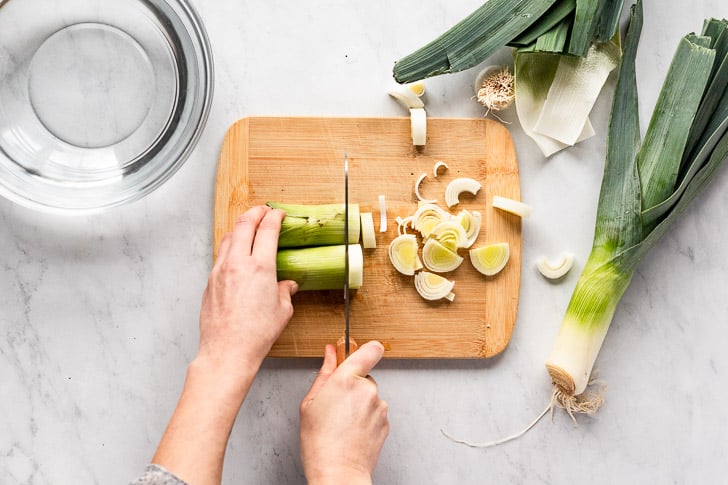
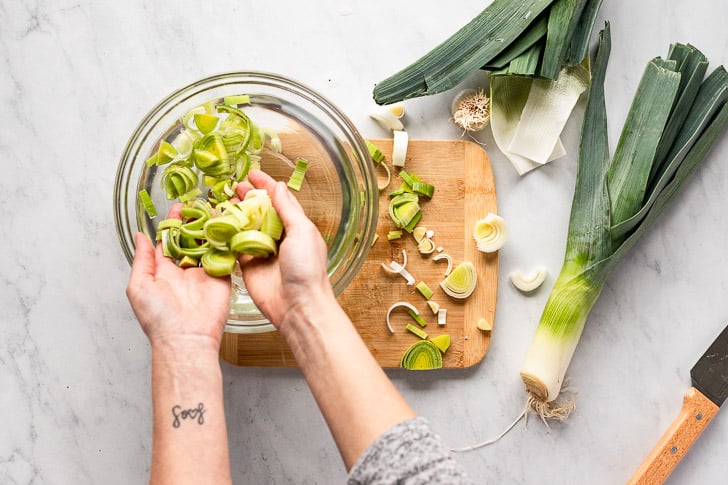
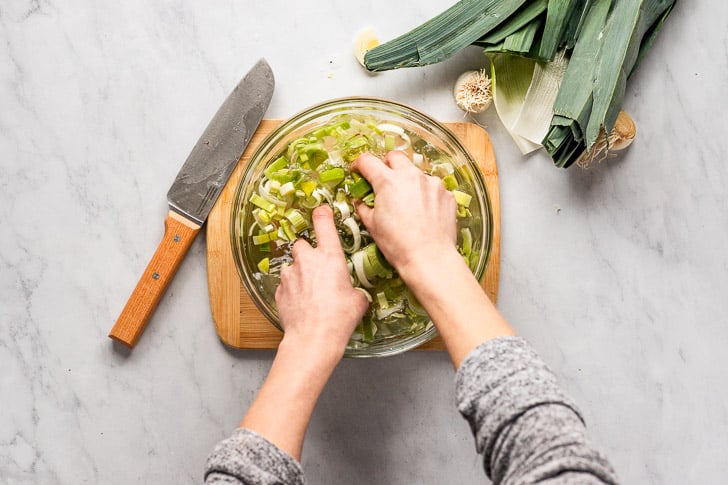
If the leeks aren’t too dirty, you can simply remove them from the water with your hands. However, I often dump them in a strainer and rinse them off to be extra sure there is no dirt left. If the water is super dirty, go ahead and repeat the process.
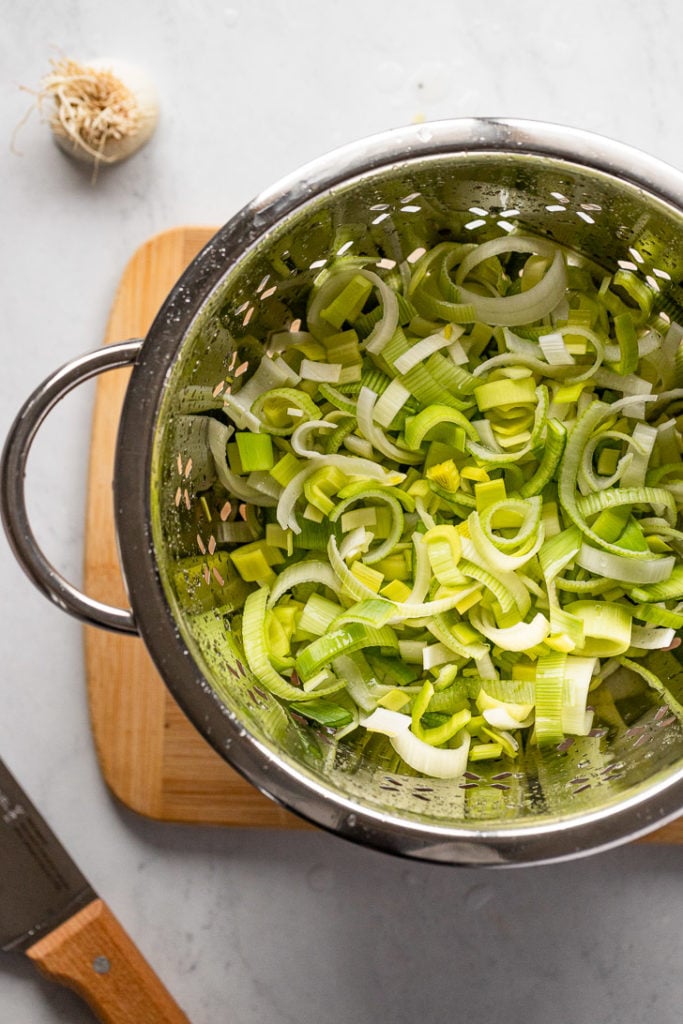
Alternatively, rinse the sliced leek in a colander and skip the soak altogether if they’re not too dirty to start with.
How to Cut Leeks
After cleaning the leeks, you’ll already have them either sliced or the leek will be cut in half, and then you can slice or chop it as needed.
For most recipes, the slices are exactly how they should be cut, because they are thin enough to saute and in general tender enough that they don’t need to be chopped any smaller as they’ll shrink down in the cooking process.
If your recipe calls for chopped or finely chopped leeks, go ahead and further chop the leeks.
If roasting, you will want to cut them into larger chunks (around 1 inch), and if grilling, stop cutting them once they’re cut in half lengthwise.
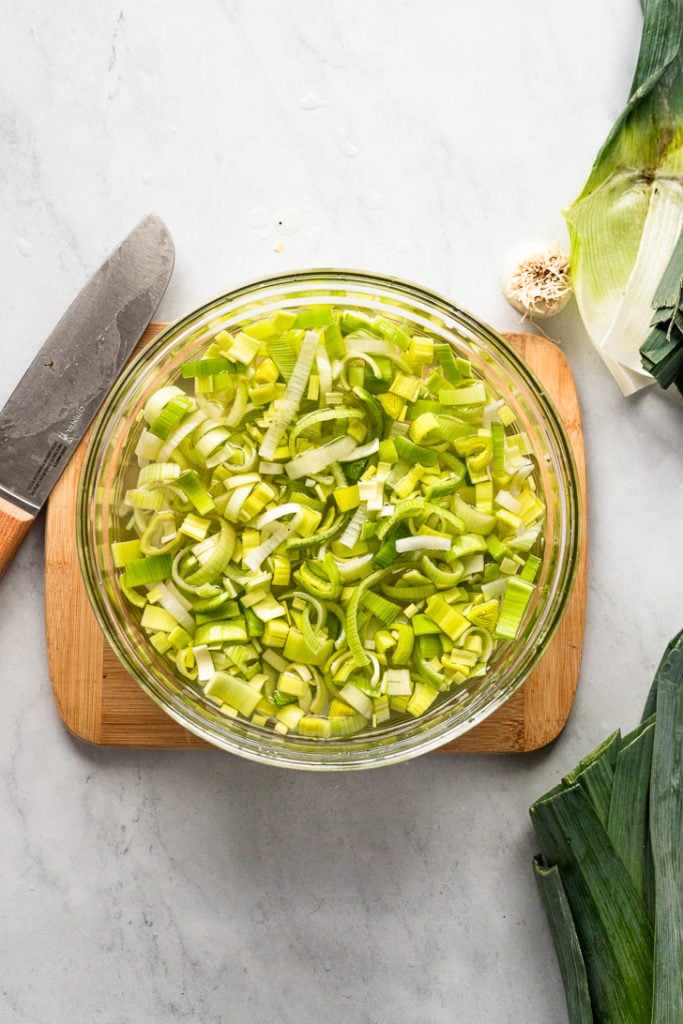
How to Cook Leeks
Leeks are often used as part of a recipe, but you can also boil, braise, roast, or saute them and enjoy them as a side or as a mix with other vegetables (add them to these green beans and mushrooms – so good!).
- To Saute (as a side or garnish or to add to a salad): heat olive oil or butter in a skillet, then add the sliced leeks (light and white parts) with a generous pinch of salt and pepper and continue cooking until tender, about 4-5 minutes.
- To Grill: keep the leek intact after cutting in half lengthwise, and dry well after cleaning. Brush with olive oil and place on cleaned grill grates, cooking until grill marks appear and they are tender; usually about 5-7 minutes over medium-high heat. Serve as a veggie side. You can also cook them in a foil packet on the grill like these onions!
- To Roast: similar to roasting root vegetables, cut them into larger 2-inch chunk pieces, toss in olive oil, salt, and pepper, then roast for about 20-25 minutes at 450F until tender, or keep cut in half lengthwise and roast for the full 40 minutes with the rest of the veggies.
How Much is One Leek Chopped?
One medium whole leek (approximately 8 ounces) will yield about 1 cup of chopped leek.
When are leeks in season?
You can find leeks year-round in your local grocery store, however, they are typically in season (with the most flavor) from autumn to early spring.
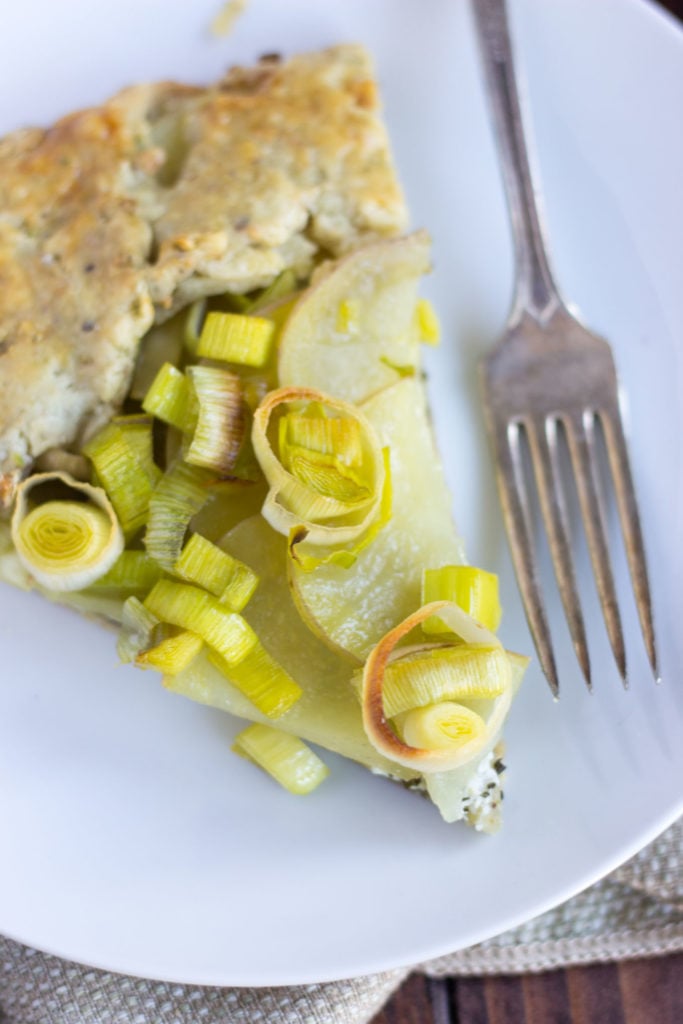
Leek Recipes
There are so many delicious recipes that are made with leeks – don’t miss the chance to cook with them! Here are a few of my favorites. I’d love to hear yours, be sure to leave a comment and let me know!
- Carrot and Leek Risotto
- Mushroom and Leek Pasta (one pot!)
- Artichoke, Leek, and Kale Dip (like spinach artichoke, but better!)
- Potato, Leek, and Rosemary Galette
- Creamy Tomato and Spinach Gnocchi (the leek in this adds SO much flavor!)
- Green Shakshuka with artichokes, leek, kale, and feta
- Hearty Root Vegetable Soup
- Substitute them for the onion in this kale quiche or this Mediterranean quiche
- Replace the onion (or half of it) for leeks in vegetarian stuffing
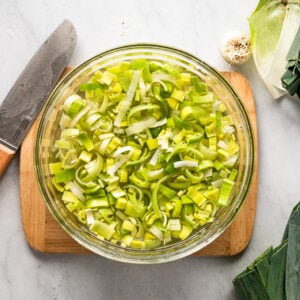
Get the Recipe How to Cut and Cook Leeks
Ingredients
- 2 medium leeks, approximately 1 pound
- Salt and pepper, as needed
- Olive Oil, as needed
Instructions
- Trim off the stringy root end of the leek, and the dark green top (starting where the light greens turns to dark green). The top is generally too tough to enjoy; reserve the top for homemade stock (you can freeze it).
- Cut the white and light green part of the leek in half lengthwise and lay the flat side down on the cutting board. Cut into 1/4 to 1/2 inch half slices. Clean properly by placing cut pieces in a bowl of water and swoosh them around to remove any dirt and sand. Drain and rinse.
- Alternatively, run water through the layers of the leek once you've cut it in half lengthwise, then continue cutting the leek as the recipe calls for.
- To Saute: heat olive oil or butter in a skillet, then add the sliced leeks (light and white parts) with a generous pinch of salt and pepper and continue cooking until tender, about 4-5 minutes.
- To Roast: similar to roasting root vegetables, cut them into larger 2-inch chunk pieces, toss in olive oil, salt, and pepper, then roast for about 20-25 minutes at 450F until tender, or keep cut in half lengthwise and roast for the full 40 minutes with the rest of the veggies.
- To Grill: keep the leek intact after cutting in half lengthwise, and dry well after cleaning. Brush with olive oil and place on cleaned grill grates, cooking until grill marks appear and they are tender; usually about 5-7 minutes over medium-high heat. Serve as a veggie side.

